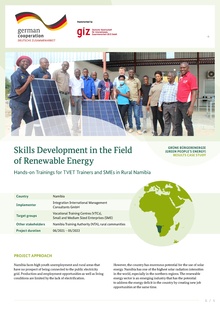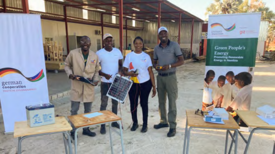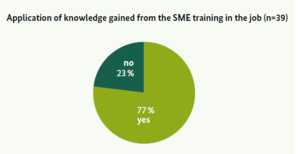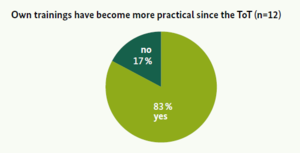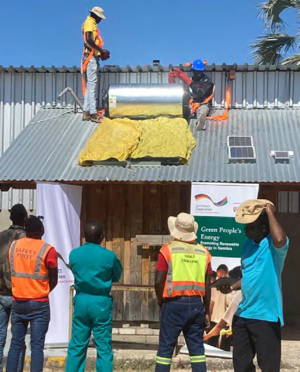Click here to register!
Difference between revisions of "Skills Development with TVET Trainers and SMEs in Rural Namibia"
***** (***** | *****) Tag: 2017 source edit |
***** (***** | *****) |
||
| (4 intermediate revisions by the same user not shown) | |||
| Line 6: | Line 6: | ||
__TOC__ | __TOC__ | ||
=='''Project Approach'''== | =='''Project Approach'''== | ||
| − | Namibia faces high youth unemployment and rural areas that have no prospect of being connected to the public electricity grid. Production and employment opportunities as well as living conditions are limited by the lack of electrification. However, the country has enormous potential for the use of solar energy. Namibia has one of the highest solar radiation intensities in the world, especially in the northern regions. The renewable energy sector is an emerging industry that has the potential to address the energy deficit in the country by creating new job opportunities at the same time. | + | [[File:Skills Development in the Field of Renewable Energy in Namibia GBE Case Study GIZ 2023.pdf|right|frameless|312x312px]]Namibia faces high youth unemployment and rural areas that have no prospect of being connected to the public electricity grid. Production and employment opportunities as well as living conditions are limited by the lack of electrification. However, the country has enormous potential for the use of solar energy. Namibia has one of the highest solar radiation intensities in the world, especially in the northern regions. The renewable energy sector is an emerging industry that has the potential to address the energy deficit in the country by creating new job opportunities at the same time. |
The idea behind this project is to strengthen the solar technology industry through skills development. By improving the skills of TVET staff and private sector professionals, the project aims to promote the quality and quantity of solar-powered installations, in particular in rural areas of northern Namibia. In cooperation with the NTA, two different trainings are developed and implemented. The trainings are very hands-on with practical exercise elements. | The idea behind this project is to strengthen the solar technology industry through skills development. By improving the skills of TVET staff and private sector professionals, the project aims to promote the quality and quantity of solar-powered installations, in particular in rural areas of northern Namibia. In cooperation with the NTA, two different trainings are developed and implemented. The trainings are very hands-on with practical exercise elements. | ||
| Line 18: | Line 18: | ||
* Solar water heaters | * Solar water heaters | ||
| − | [[File:Training participants from public and private VTCs.png|thumb|275x275px|Training participants from public and private VTCs|alt=]]A detailed handbook with additional content is developed for this training, which can also be used by TVET trainers when teaching the content of their regular courses (e.g. “Solar Equipment Installation and Maintenance”). The other training is aimed at professionals from SMEs, including start-ups, working in the photovoltaic sector. The five-day training covers the topics of: | + | [[File:Training participants from public and private VTCs.png|thumb|275x275px|Training participants from public and private VTCs|alt=]] |
| − | + | A detailed handbook with additional content is developed for this training, which can also be used by TVET trainers when teaching the content of their regular courses (e.g. “Solar Equipment Installation and Maintenance”). The other training is aimed at professionals from SMEs, including start-ups, working in the photovoltaic sector. The five-day training covers the topics of: | |
* Solar PV systems | * Solar PV systems | ||
* Solar water pumping systems | * Solar water pumping systems | ||
* Solar thermal systemsThe SME training is facilitated by TVET teachers trained at the ToT together with staff from the training provider. This allows VTC trainers to apply the knowledge and teaching methods they have learned. Both trainings take place at the Eenhana Vocational Training Centre (EVTC), which is suitable due to its geographical location and teaching equipment, which is further expanded through additional procurements funded by the project. The solar training for SMEs serves as a pilot project for the EVTC to enhance its capacity to offer more short courses in renewable energy and thereby generate income in future. | * Solar thermal systemsThe SME training is facilitated by TVET teachers trained at the ToT together with staff from the training provider. This allows VTC trainers to apply the knowledge and teaching methods they have learned. Both trainings take place at the Eenhana Vocational Training Centre (EVTC), which is suitable due to its geographical location and teaching equipment, which is further expanded through additional procurements funded by the project. The solar training for SMEs serves as a pilot project for the EVTC to enhance its capacity to offer more short courses in renewable energy and thereby generate income in future. | ||
| − | |||
| − | |||
| − | |||
| Line 60: | Line 57: | ||
=='''Conclusion and Outlook'''== | =='''Conclusion and Outlook'''== | ||
| − | The two planned trainings were successfully delivered, and the needs of training participants were carefully considered in the design of the trainings. Around three quarters of the SME training participants state that the training is highly relevant to their work. Some 58 % of TVET trainers rate their training as highly relevant, with further 33 % and 9 % rating the training as moderately and slightly relevant, respectively. Apart from very few exceptions the trainings met the needs and expectations of the participants. | + | [[File:Picture 2- Installation of a solar water heating system.png|left|thumb|Installation of a solar water heating system]]The two planned trainings were successfully delivered, and the needs of training participants were carefully considered in the design of the trainings. Around three quarters of the SME training participants state that the training is highly relevant to their work. Some 58 % of TVET trainers rate their training as highly relevant, with further 33 % and 9 % rating the training as moderately and slightly relevant, respectively. Apart from very few exceptions the trainings met the needs and expectations of the participants. |
Various positive and sustainable training effects can be observed. By strengthening the capacities of VTC trainers and SME employees, the project contributes to the development of the solar sector. This helps to address the challenges of unemployment and low electrification rates in rural Namibian areas. Capacity building is an essential factor in realising Namibia’s own ambitions regarding the expansion of the solar sector, or as one interviewed solar entrepreneur said: “The catalyst to unlock the potential”. | Various positive and sustainable training effects can be observed. By strengthening the capacities of VTC trainers and SME employees, the project contributes to the development of the solar sector. This helps to address the challenges of unemployment and low electrification rates in rural Namibian areas. Capacity building is an essential factor in realising Namibia’s own ambitions regarding the expansion of the solar sector, or as one interviewed solar entrepreneur said: “The catalyst to unlock the potential”. | ||
Latest revision as of 13:18, 22 March 2024
Skills Development with TVET Trainers and SMEs in Rural Namibia
Project Approach
Namibia faces high youth unemployment and rural areas that have no prospect of being connected to the public electricity grid. Production and employment opportunities as well as living conditions are limited by the lack of electrification. However, the country has enormous potential for the use of solar energy. Namibia has one of the highest solar radiation intensities in the world, especially in the northern regions. The renewable energy sector is an emerging industry that has the potential to address the energy deficit in the country by creating new job opportunities at the same time.The idea behind this project is to strengthen the solar technology industry through skills development. By improving the skills of TVET staff and private sector professionals, the project aims to promote the quality and quantity of solar-powered installations, in particular in rural areas of northern Namibia. In cooperation with the NTA, two different trainings are developed and implemented. The trainings are very hands-on with practical exercise elements.
One training is a Training of Trainers (ToT) for the trainers of the VTCs. The training lasts five days and covers the following topics:
- Introduction to energy systems
- The solar energy resource,
- (Off grid) solar PV systems
- PV pumping systems
- Solar water heaters
A detailed handbook with additional content is developed for this training, which can also be used by TVET trainers when teaching the content of their regular courses (e.g. “Solar Equipment Installation and Maintenance”). The other training is aimed at professionals from SMEs, including start-ups, working in the photovoltaic sector. The five-day training covers the topics of:
- Solar PV systems
- Solar water pumping systems
- Solar thermal systemsThe SME training is facilitated by TVET teachers trained at the ToT together with staff from the training provider. This allows VTC trainers to apply the knowledge and teaching methods they have learned. Both trainings take place at the Eenhana Vocational Training Centre (EVTC), which is suitable due to its geographical location and teaching equipment, which is further expanded through additional procurements funded by the project. The solar training for SMEs serves as a pilot project for the EVTC to enhance its capacity to offer more short courses in renewable energy and thereby generate income in future.
Methodology of Data Collection
Data for this case study report was collected through a review of project documents, five qualitative interviews with representatives of GIZ, NTA, the training provider, one VTC and one solar company that sent three employees to the SME training, as well as quantitative surveys among participants of both trainings approximately six months after the trainings. All twelve participants of the ToT training as well as 39 of the 60 SME training participants took part in the surveys. The case study was conducted between December 2022 and May 2023.
Key Findings
Project Achievements
The conducted trainings have improved the capacities of both, the TVET trainers and the SME employees. The training participants (around 25 % of ToT and 17 % of the SME training participants are women) apply the gained knowledge in their work. While all ToT participants indicate in the survey that they apply the gained knowledge, around 77 % of the trained SME employees do so (see figure 1).When asked for concrete examples, some training participants were able to give specific examples, such as one TVET trainer: "It is easy to explain the different types of water pumps and the reasons for pumping water.”
The SME training helped not only to pass on new content, but also to deepen existing knowledge and apply it correctly in everyday work, as the following statement by a training participant shows: “The training really pushed us in the direction of doing things the right way”. For example, the participants learned how important the tilt of the solar panel is to optimise the energy yield. Another positive achievement is that the project has encouraged the exchange between professionals from different SMEs and also between industry staff and TVET trainers.
Intermediate Impact
The skills development measure for SME has led to various positive effects, both at individual and organisational level. At the individual level, the training contributed to income increases for 41 % of the trainees, which can largely be explained by new jobs in the same or another organisation/company (see figure 2).An overwhelming majority of SME trainees report that their job performance has improved and they have acquired new tasks as a result of the training (see figure 2). This leads directly to benefits for the employers. One company owner explained, for example, that his trained salesperson has a better understanding of the overall PV system design and is more confident to make quotations on her own without involving additional colleagues. This saves time and ultimately costs for the company. Quantitative survey data as well as testimonies from individuals indicate that the project has a positive impact on the private sector and on rural communities, as one SME trainee describes: “A very good initiative for the communities and upcoming companies. The practical and theory opens our minds on how to cut costs by using natural resources.”The training activity for the TVET trainers has – as expected – not led to an improvement in the teachers’ life situation, e.g. in terms of career and income increase, as was the case for some of the SME trainees, but has improved the quality of their teaching. Almost all TVET trainers state that they have improved the content of their existing training courses and their didactic approach. Furthermore, a clear majority indicate an improved practical orientation of their own teaching after participating in the ToT (see figure 3).The TVET trainers estimate that they have passed on the acquired skills to more than 650 students, of whom about 25 % are women. This could lead to further positive effects in the future if the students could use of the knowledge imparted. All in all, it seems plausible that the trainings for TVET traners and SME employees have promoted the installation of solar technology in Namibia, addressing the challenges of unemployment and low electrification rates in rural areas.
Challenges in Project Implementation
One challenge was the procurement of equipment required to conduct the trainings. International procurement took longer than expected (e.g. due to customs regulations) and local supply options for the training kits used by the training provider are very limited in Namibia. As a result, some equipment needed for the practical exercises, such as a water pump and an instrument to measure solar radiation were not available. Another challenge is the mobilisation of women for the trainings. Although women’s participation was highlighted as particularly desirable in the advertising for the training measures, the participation rate remained significantly behind that of men. This can probably be explained by the fact that the sector has so far predominantly employed men. The different background of training participants also posed a challenge, as people with a technical background in plumbing and piping have different training needs in electricity than educated electricians.
Lessons Learned
An online ToT training needs analysis was conducted before the training among ten TVET trainers, revealing their requirements. The assessment shows that for many PV topics (e.g. structure and functioning of different types of solar cells or structure and functioning of batteries) about 4 out of 10 trainers do not feel confident to teach these aspects. When asked about practical applications (e.g. design and installation of an off-grid PV system), even less than half state they are confident in their own knowledge and skills. A particular interest in learning more about solarpowered water pumps can be observed.
Overall, the needs assessment shows that there is a high demand for training measures that also cover basic PV topics. Regular training to refresh, update and expand existing knowledge is necessary not only in the private sector, but also for teachers in educational institutions. For the SME training the very high interest from the private sector is an important lesson learned. The project has received around 100 eligible applications for the training, while only 60 places were available. Marketing for the training was done through NTA via various social media platforms. With more intensive advertising, probably even more applications could have been generated. The costs for transport and accommodation had to be covered by the companies themselves, which shows that they are willing to invest into the capacity building of their employees.
To accommodate the different technical backgrounds of the training participants, an additional introductory lecture on the basics of electricity was offered to the trainers and the SME trainees. This was necessary so that people with a background in plumbing and piping could catch up and be prepared to receive training on photovoltaic systems. Although practical sessions were part of the training, an even stronger focus could be placed on practical exercises when conducting comparable capacity building measures. Sufficient equipment is needed for this.
Sustainability of the Intervention
In general, the conducted capacity building has a sustainable impact because both targets groups (TVET trainers and SME professionals) use the gained knowledge in their work. However, not all training participants successfully apply the knowledge they have learned or, in the case of the VTC trainers, pass it on to future trainees, as one SME training participant points out: „Some of the trainers were not well equipped with all the necessary skills to give the training“. Training material was created to promote the use of the training content in the long term. While 92 % of VTC trainers confirm that they have received training material and 83 % also use it, only about half of the SME trainees state that they have received and use training material. The project’s plan for the EVTC to continue running courses to SMEs on its own after the end of the project in order to strengthen the capacities of the private sector and at the same time generate income for the EVTC could not yet be realised at the time of the case study. The EVTC still has the plan to conduct one training in 2023, but very concrete progress in this regard could not be observed yet.
Conclusion and Outlook
The two planned trainings were successfully delivered, and the needs of training participants were carefully considered in the design of the trainings. Around three quarters of the SME training participants state that the training is highly relevant to their work. Some 58 % of TVET trainers rate their training as highly relevant, with further 33 % and 9 % rating the training as moderately and slightly relevant, respectively. Apart from very few exceptions the trainings met the needs and expectations of the participants.Various positive and sustainable training effects can be observed. By strengthening the capacities of VTC trainers and SME employees, the project contributes to the development of the solar sector. This helps to address the challenges of unemployment and low electrification rates in rural Namibian areas. Capacity building is an essential factor in realising Namibia’s own ambitions regarding the expansion of the solar sector, or as one interviewed solar entrepreneur said: “The catalyst to unlock the potential”.
Upscaling potential exists on the one hand by replicating the provided trainings. EVTC may be able to offer further trainings to the solar industry, as there seems to be a demand and willingness among private sector stakeholders to invest in training. There could also be further upscaling opportunities in other parts of the country, although it seems difficult to find a partner organisation equivalent to EVTC to carry out similar trainings in other parts of Namibia. Considering the huge geographical distances in Namibia and the limited number of suitable training locations, a mobile training concept/unit might be considered for training replication activities On the other hand, upscaling could be done by introducing more advanced capacity building measures. Currently, the VTCs in Namibia can offer training up to level 3 (solar artisan) of the National Qualification Framework. Level 5 (solar technician) would be desirable for the VTCs. Based on this, graduates could then even go on to study engineering at university.
The project has improved the capacity of the VTCs to provide a better quality for existing courses, but the scope of training activities was too small to significantly raise the skill level of TVET trainers. To enable the VTCs to offer training up to level 5, the VTCs trainers would need comprehensive further training that can lead to a recognized qualification. This approach would entail to develop a new curriculum which would need to be aligned and integrated into the national education plan. This could be worthwhile, but also requires several years of time and a corresponding commitment of resources.

